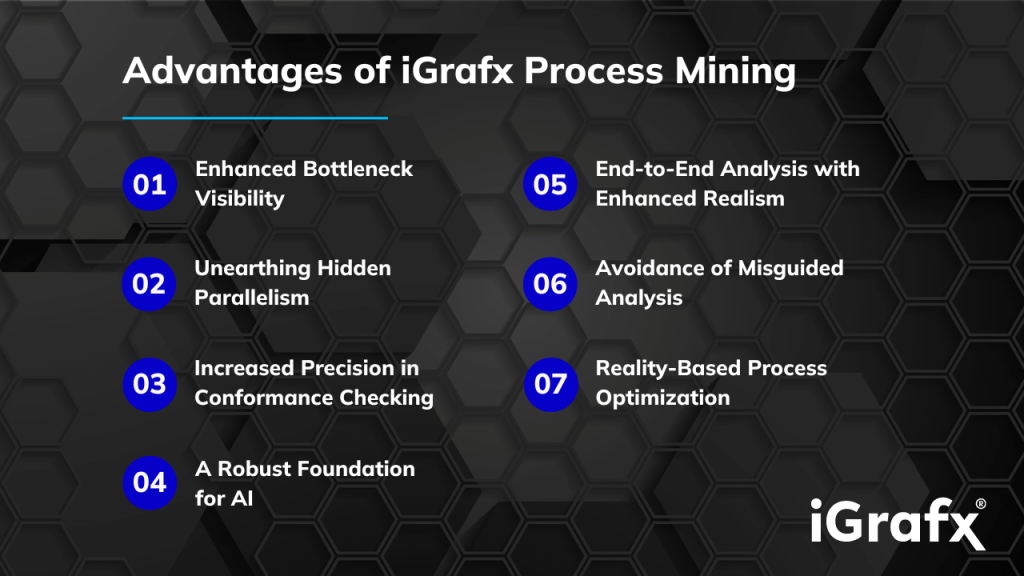Introduction
Process Mining technology empowers businesses to dissect and understand their operational workflows through the lens of data harvested from their own information systems. Traditional Process Mining algorithms typically focus on a singular timestamp for each activity, which is generally when the activity is complete.
The iGrafx Process Mining algorithm leverages a novel approach based on two timestamps (the beginning and end of an activity). As a result, activity duration can be measured. Most importantly however, is that this gives rise to analysis of activities that happen concurrently, breaking the traditional linear lens through which Process Mining visualizations are presented.
This blog delves into how this new algorithm provides tremendous value to organizations by being more intuitive, accurate, and performant than algorithms used by other Process Mining vendors.
iGrafx’s Process Mining Innovation
What sets this novel algorithm apart is its ingenious ability to capture two temporal dimensions for each task: the initiation and the conclusion. This dual-timestamp approach enables a far more granular and comprehensive analysis of activity durations and the intervals of inactivity between them. These durations are the foundation for detecting what activities in a process are happening at the same time.
Other step-change improvements in Process Mining technology such as object-centric Process Mining (OCPM) algorithms fall short on the ultimate goal of true process visibility without factoring in the aforementioned concurrency analysis. Bottlenecks would be left undiscovered, ROI would be improperly calculated, and change management programs would be less effective. Let’s look at the benefits afforded as a result of this novel algorithm.
An Algorithm That Enhances Predictive Analytics and AI
iGrafx’s Process Mining, offering far more accurate and representative process discovery, significantly boosts the precision and correctness of AI models when these discovered processes are utilized for Predictive Analytics or other AI-driven applications. This leap in accuracy empowers iGrafx to provide the pinnacle of this technology, ensuring that their predictive insights and prescriptive guidance are not only precise but also highly reliable.
Advantages of iGrafx Process Mining Technology Over Traditional Algorithms
Enhanced Bottleneck Visibility
By pinpointing the exact start and end of tasks, bottlenecks are identified more effectively. Traditional algorithms would highlight the time between two activities as a bottleneck, when one activity could be the true bottleneck.
Unearthing Hidden Parallelism
Parallelism is something we experience in our day to day. When making a meal, you may have food cooking in the oven while you’re preparing a sauce at the same time. Business processes are no different. Traditional Process Mining algorithms misinterpret concurrent activities as sequential; whereas the iGrafx algorithm distinctly identifies activities that occur concurrently. Understanding the reality of the process execution makes any sort of process re-engineering or change management effort more effective.
Increased Precision in Conformance Checking
Conformance checking compares actual process performance against a desired process model (typically a “gold standard”). These models exist in BPMN format and already explicitly describe parallelism in processes. Traditional Process Mining algorithms cannot do conformance checking with a high level of fidelity because they don’t capture this parallelism, causing a classic apples to oranges situation.
A Robust Foundation for AI
Detailed activity duration data collection provides an enriched dataset on which artificial intelligence can be applied. AI predictive and prescriptive models grow more robust by integrating precise measures of duration and intervals. This data richness allows AI to deliver more nuanced insights and predict process behaviors with superior accuracy. Because traditional Process Mining technology algorithms do not represent the process accurately, the predictions made on those processes are also inaccurate.
End-to-End Analysis with Enhanced Realism
End-to-end process analysis is crucial for a complete understanding of a company’s operations. In reality, processes are rarely linear; they involve activities that often occur in parallel. Without proper consideration of parallelism, traditional Process Mining algorithms might offer an oversimplified and thus inaccurate portrayal of processes. The iGrafx algorithm presents the process in an intuitive way, just as a normal person would describe it.
Avoidance of Misguided Analysis
Neglecting parallelism in processes can lead to flawed analysis, where optimization opportunities are overlooked. Mistakenly assuming tasks are purely sequential, companies might misdirect their improvement efforts or miss out on substantial efficiency gains. The iGrafx algorithm sidesteps this pitfall by revealing the true nature of processes, which often includes concurrent task execution.
Reality-Based Process Optimization
By acknowledging and measuring parallelism, companies can optimize their processes based on accurate data. This not only identifies where and how resources can be better utilized but also adapts processes to capitalize on activities that can be performed simultaneously, thus shortening lead times and boosting productivity.
Conclusion
Adopting a Process Mining technology that leverages an algorithm built on multiple timestamps and parallelism detection yields significant benefits over traditional methods. This innovative approach affords a more complete and detailed understanding of operational processes, which translates to improved bottleneck identification, precise parallelism analysis, more accurate conformance checking, and a robust foundation for leveraging artificial intelligence. While rival solutions, such as those from Celonis, currently lead the market, this new algorithm redefines Process Mining technology standards and catapults businesses to unparalleled levels of efficiency and performance.
The implementation of a Process Mining algorithm that captures two timestamps for each task is pivotal for an accurate and realistic analysis of operational processes. By embracing the inherent parallelism in real-world business activities, this algorithm sidesteps the pitfalls of oversimplified analysis and paves the way for improvements grounded in the true dynamics of processes. Moreover, this method lays a solid groundwork for advanced analyses, including the use of artificial intelligence, to push the boundaries of business process understanding and optimization even further.


